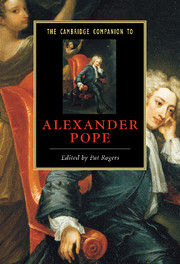Book contents
- Frontmatter
- Introduction
- 1 Pope, self, and world
- 2 Pope’s friends and enemies: fighting with shadows
- 3 Pope’s versification and voice
- 4 Poetic spaces
- 5 Pope’s Homer and his poetic career
- 6 Pope and the classics
- 7 Pope and the Elizabethans
- 8 Pope in Arcadia: pastoral and its dissolution
- 9 Pope and ideology
- 10 Pope and the poetry of opposition
- 11 Crime and punishment
- 12 Landscapes and estates
- 13 Money
- 14 Pope and the book trade
- 15 Pope and gender
- 16 Medicine and the body
- 17 Pope and the other
- Further reading
- Index
11 - Crime and punishment
Published online by Cambridge University Press: 28 April 2008
- Frontmatter
- Introduction
- 1 Pope, self, and world
- 2 Pope’s friends and enemies: fighting with shadows
- 3 Pope’s versification and voice
- 4 Poetic spaces
- 5 Pope’s Homer and his poetic career
- 6 Pope and the classics
- 7 Pope and the Elizabethans
- 8 Pope in Arcadia: pastoral and its dissolution
- 9 Pope and ideology
- 10 Pope and the poetry of opposition
- 11 Crime and punishment
- 12 Landscapes and estates
- 13 Money
- 14 Pope and the book trade
- 15 Pope and gender
- 16 Medicine and the body
- 17 Pope and the other
- Further reading
- Index
Summary
Poetry and punishment in the early works
Punishment was more physical, and more visible, in Pope's day than it is in ours. The pillory was still in use at various locations around London, as were public whippings. Eight times a year those condemned to death were taken from Newgate Prison to Tyburn to be hanged: crowds lined the route and gathered for the show. Crime and punishment spawned their own literature, and Pope's lifetime coincided with an explosion in crime-related writing of all kinds. “Proceedings” at the Old Bailey were published regularly from the 1680s. Trials and punishments were widely reported in the newspapers; criminal biography (in both documentary and fictional forms) flourished. On the other side, as it were, there was considerable professional crossover between law and writing: many writers were educated at the Inns of Court, including such notable friends of Pope as Congreve, Rowe, and Warburton. Pope was friendly with several lawyers; one of them was celebrated in “Presentation Verses to Nathaniel Pigott,” and another, William Murray, later the Earl of Mansfield, was the addressee of the Sixth Epistle of the First Book of Horace Imitated.
Owen Ruffhead, Pope's first official biographer and himself a barrister, declared that Pope intended his work as a “supplement to the public laws,” and the metaphorical “lash” of satire was regularly invoked as his model. But Pope's attitude to crime and the law was actually much more complex than this. In an early letter to Henry Cromwell (1 November 1708 [Corr, i, pp. 51-2]), Pope jokingly compared his entry into print to a public execution, and likened Tonson's Miscellanies to the regular collections of malefactors' lives put out by the Ordinary (Chaplain) of Newgate.
- Type
- Chapter
- Information
- The Cambridge Companion to Alexander Pope , pp. 150 - 160Publisher: Cambridge University PressPrint publication year: 2007

